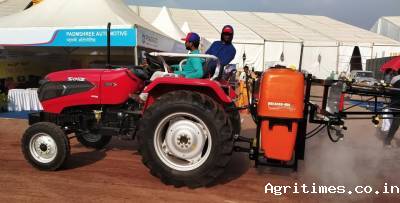MUMBAI, 19 May 2025: The global agricultural tractors market is poised for significant growth, driven primarily by the increasing adoption of precision farming techniques and strong governmental support for the agriculture sector worldwide.
Additionally, the rising demand for fuel-efficient tractors and rapid technological advancements in tractor design and functionality are expected to open new avenues for market expansion.
Valued at approximately $59.1 billion in 2021, the agricultural tractors market is projected to reach $97.8 billion by 2031, growing at a compound annual growth rate (CAGR) of 5.6?tween 2022 and 2031. One of the key factors fueling this growth is the ongoing surge in urbanization, which has led to a shortage of skilled labor in agricultural activities. This labor gap is expected to drive farmers and agribusinesses to increasingly rely on mechanized solutions such as tractors.
Market Segmentation and Trends
By drive type, the 2-wheel drive (2WD) segment dominated the market in 2021, accounting for roughly 90% of the market share. This dominance is attributed to the cost-effectiveness and ease of use associated with 2WD tractors, which make them popular among small and medium-scale farmers. However, the 4-wheel drive (4WD) segment is forecasted to register the fastest growth, with a CAGR of 7.4% during the forecast period. The versatility, higher traction, and greater productivity of 4WD tractors are key factors expected to expand their adoption, particularly in challenging terrains and larger farms.
When analyzed by operation type, manual transmission tractors currently generate the highest revenue, capturing around 90% of the market in 2021. These tractors are favored for power take-off (PTO)-intensive tasks and provide farmers with reliable and proven technology. Conversely, autonomous tractors are emerging as a promising segment, anticipated to achieve a robust CAGR of 26.2% during the forecast period. The integration of automation technologies in agriculture, aimed at improving efficiency, precision, and labor savings, is driving demand for autonomous tractors worldwide.
Regional Insights
Geographically, the Asia-Pacific region emerged as the largest market for agricultural tractors in 2021, contributing to about half of the global revenue. This region is also expected to be the fastest growing market, with a CAGR of 6.3% over the next decade. Economic growth, rising investments in agricultural infrastructure, and modernization efforts in countries such as India, China, and Southeast Asian nations are the main factors driving this expansion.
Technological Innovations and Sustainability
The agricultural tractors market is witnessing a shift toward sustainable and environmentally friendly technologies. Leading equipment manufacturers are investing in the development of zero-emission tractors powered by electric and hydrogen fuel technologies. Research and development activities focused on electric tractors and hydrogen-fueled alternatives have intensified in recent years, reflecting a global trend towards reducing carbon footprints in farming.
Key Industry Players
Several established companies dominate the agricultural tractor market, including Captain Tractors Pvt. Ltd, CNH Industrial N.V., Deere & Company, Eicher Tractors, Escorts Limited, Fendt (AGCO GmbH), Force Motors Limited, Gromax Agri Equipment Limited, J C Bamford Excavators Ltd., KUBOTA Corporation, Mahindra & Mahindra Ltd., Monarch Tractor, SDF Group, SOLECTRAC, Sonalika International Tractors Ltd, Standard Corporation India Limited, and Yanmar Co., Ltd. These players are driving market growth by introducing innovative products and expanding their geographical reach.
Outlook
The global agricultural tractors market is set for robust growth, supported by increasing mechanization, government initiatives, and technological breakthroughs. As more farmers adopt precision farming and automation, the demand for advanced, fuel-efficient, and zero-emission tractors is expected to accelerate. With rising urbanization and labor shortages, tractors will remain vital to enhancing farm productivity and sustainability, especially in emerging economies across Asia-Pacific.




















